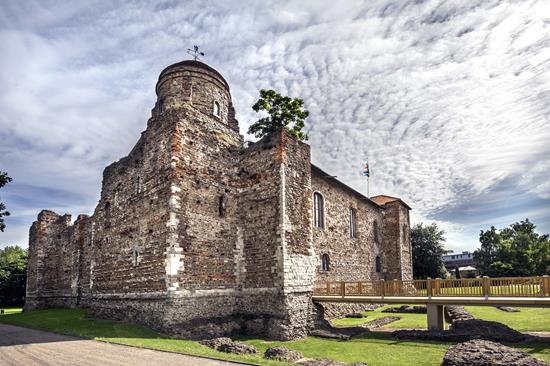The Temple of Claudius was the largest temple building in Roman Britain, an indication of Colchester’s status and the focus for the worship of the emperor and his successors. A temple already existed at the time of the revolt of Queen Boudica in AD 60 and it is referred to in the historical account of the destruction of the town. Today, only the foundations of the original temple survive below Colchester Castle.
The inside of the temple was reserved for priests to worship the spirit of the emperor; everyone else would have gathered outside in a large enclosed space known as the precinct. It is likely the precinct would have housed a statue of Claudius and an altar, approached through a monumental arch.
At the end of the Roman period, the temple may have been used as a Christian church before it fell into disuse. The whole site was largely abandoned for centuries, although shortly before the Norman Conquest a Saxon chapel was constructed among the ruins. The Normans recognised the importance of the temple site, both as a legacy of an ancient past and as an excellent location for their castle as they realised they could use the existing foundations. Today, these remains – the Vaults, as they became known in the eighteenth century – can be visited on guided tours of Colchester Castle.
 This Norman keep known as Colchester Castle was built around AD 1078 on the foundations of the Roman Temple of Claudius. It was built in at least two main phases and its initial form consisted of a single-storey stone keep with crenellated parapet wall. During the early 12th century, the keep's outer walls were raised by at least one storey and a fore-building was added on the south side to protect the main entrance. A barbican replaced this in the 13th century. The castle's earthwork defences consisted of an upper and 'nether' or lower bailey bank and ditch (to the north, and down-slope to the town wall) with at least one entrance in the upper bailey's south-west corner. The upper bailey defences had been built by 1101. The northern and eastern arms of the upper bailey defences survive as landscaped earthworks within Castle Park. The southern arms lies just to the north of the High Street, and the western arm, below or just to the east of Maidenburgh Street. The nether bailey is possibly part of a second phase, of the late 12th century. The southern end of the eastern arm of the nether bailey survives as a landscaped ditch in Castle Park. The western arm lies below or just to the east of Maidenburgh Street. A masonry chapel and domestic buildings stood to the south of the keep. The keep was partially demolished in the 17th century.
This Norman keep known as Colchester Castle was built around AD 1078 on the foundations of the Roman Temple of Claudius. It was built in at least two main phases and its initial form consisted of a single-storey stone keep with crenellated parapet wall. During the early 12th century, the keep's outer walls were raised by at least one storey and a fore-building was added on the south side to protect the main entrance. A barbican replaced this in the 13th century. The castle's earthwork defences consisted of an upper and 'nether' or lower bailey bank and ditch (to the north, and down-slope to the town wall) with at least one entrance in the upper bailey's south-west corner. The upper bailey defences had been built by 1101. The northern and eastern arms of the upper bailey defences survive as landscaped earthworks within Castle Park. The southern arms lies just to the north of the High Street, and the western arm, below or just to the east of Maidenburgh Street. The nether bailey is possibly part of a second phase, of the late 12th century. The southern end of the eastern arm of the nether bailey survives as a landscaped ditch in Castle Park. The western arm lies below or just to the east of Maidenburgh Street. A masonry chapel and domestic buildings stood to the south of the keep. The keep was partially demolished in the 17th century.
Colchester Castle is now home to Colchester Castle Museum where visitors can explore the Roman vaults and visit the roof of the castle for panoramic views around the town. The museum's collections focus on the history of Colchester and include many very significant finds such as the Kelvedon Warrior and the 'Fenwick hoard', a collection of Roman jewellery found under the Fenwick store on High Street, Colchester.
 This Norman keep known as
This Norman keep known as